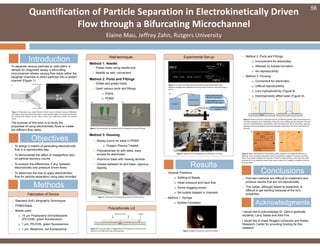
Zahn_poster_4_19
- 1. Quantification of Particle Separation in Electrokinetically Driven Flow through a Bifurcating Microchannel Elaine Mau, Jeffrey Zahn, Rutgers University Introduction To separate various particles or cells within a sample for diagnostic assay, a bifurcating microchannel utilizes varying flow ratios within the daughter channels to direct particles into a certain channel (Figure 1). Figure 1: Bifurcation Law using Pressure Driven Flows a) Greater pressure difference and higher shear force causes particle to move towards higher flow branch b) Position of centroid with respect to the critical stream line determines where the particle flows. The purpose of this work is to study the properties of using electrokinetic flows to create the different flow ratios. Objectives To design a means of generating electrokinetic flow in a reproducible way To demonstrate the effect of voltage/flow ratio on particle recovery counts To analyze the differences, if any, between electrokinetic and pressure driven flows. To determine the how to apply electrokinetic flow for particle separation using data recorded Methods Fabrication of Device Standard Soft Lithography Techniques PDMS/Glass Beads used: 15 m Polystyrene Divinylbenzene (PS-DVB), green fluorescence 1 m, PS-DVB, green fluorescence 1 m, Melamine, red fluorescence Well techniques Poked holes using needle end Needle as well, convenient 56 Method 1: Needle Drilled and poked holes Used various ports and fittings Epoxy PDMS Method 2: Ports and Fittings Figure 2: Early methods for creating wells (a) Needle (b) Ports and Fitting. Biopsy punch for wells in PDMS Oxygen Plasma Treated Polycarbonate lid with wells, easy access for electrodes Aluminum base with viewing window Grease between lid and base, vigorous tapping Method 3: Housing Figure 3: Housing (a) ProEngineering model (b) Actual Device Polycarbonate Lid Figure 4: To test the affect of Magnalube-G PTFE grease on lid, the lid was placed on the table with and without grease. Experimental Set-up a) b) Figure 5: To create the high and low flow rates using electrokinetic flow, different voltages were applied at the end of each reservoir, such as the figure above. Figure 6: System used for experiment a) Schematic b) Actual. a) b) Results General Problems Settling of Beads Head pressure and back flow Some clogging issues No bubble trapped in channels Method 1: Syringe Bubble Formation Method 2: Ports and Fittings Inconvenient for electrodes Affected by bubble formation No reproducibility Method 3: Housing Convenient for electrodes Difficult reproducibility Lid’s hydrophobicity (Figure 8) Electrophoretic effect seen (Figure 9) Figure 7: Bubble formation at tip of the needle. Figure 9: When electrokinetic flow worked, beads traveled in the opposite direction as expected. (a) 1 µm beads polystyrene beads traveled from negative to positive terminal. Most 15 µm beads followed the direction of flow for small particles; a few went the other direction (b) 1 µm melamine beads were seen to travel from negative to positive terminal and vise versa. a) b) a) b) Figure 8: Results of test for polycarbonate lid. (a) Without grease, water would spread on the table; however, when assembled, there was some leaking and electrokinetic flow did not occur. (b) With grease, hydrophobic effect was observed. When assembled, vigorous tapping occasionally allowed connection between water from the lid and and that from the well. a) b) Conclusions Acknowledgments I would like to acknowledge Dr. Zahn’s graduate students, Larry Sasso and Alex Fok. I would like to thank Rutgers University and Aresty Research Center for providing funding for this research. First two methods are difficult to implement and produce results that are not reproducible The holder, although easier to assemble, is difficult to get working because of the lid’s properties.
